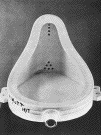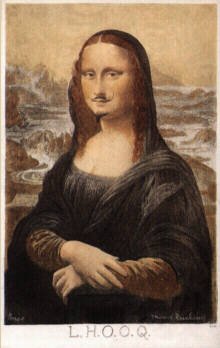
readymade or ready-made
- An object manufactured
for some other purpose, presented by an artist as a work of art.
Between 1914 and 1921, Marcel Duchamp (French, 1887-1968), who
originated this concept,
selected and signed, among others, a snow shovel, a comb, and
a urinal. He occasionally altered readymades (sometimes called
assisted readymades) — the most famous of which was a cheap reproduction of Mona Lisa
on which Duchamp drew a mustache.
Examples:

Marcel Duchamp (French-American, 1887-1968),
Bicycle Wheel, 1913 / 1964, metal, painted
wood, 126.5 x 31.5 x 63.5 cm,
Georges Pompidou Center, Paris. Duchamp called this "an
assisted readymade." See anti-art
and Dada.

Marcel Duchamp, Fountain, 1917, white glazed ceramic
plumbing fixture and painted signature, readymade porcelain urinal on its back, 63 x 48 x 35
cm. The urinal, purchased from "Mott Works" company
in New York and signed "R. Mutt," was submitted to
the jury-free 1917 Independents exhibition
but was suppressed by the hanging committee. This is a photograph
of either the second version of 1951 or the third of 1964. The
Georges Pompidou Centre in Paris publishes a color photo of it. See fountain and transgressive art.

Marcel Duchamp, Hat Rack, 1917 / 1964, wood,
27 x 44.5 cm, Georges Pompidou Center, Paris.

Marcel Duchamp, L.H.O.O.Q., 1919, "rectified readymade," pencil
on a reproduction — a chromolithograph, 7 3/4 x 4 7/8 inches, private collection,
Paris. As if the addition of mustache and beard weren't enough
of a poke at this most famous of paintings, the letters Duchamp
penciled — L.H.O.O.Q. — at the bottom of his altered image
are meaningless in themselves, but when read aloud in French,
make the sound of "Elle a chaud au cul," meaning, "She
has a hot ass." See aerial
perspective, Renaissance,
and sfumato.
[New  York:
VVV], 1942-1944, publisher, VVV, No. 1 (June 1942)-no. 4 (Feb. 1944),
serial; 4 no. in 3: illustrations
(some colored); 28 cm., irregular; Metropolitan Museum of Art,
NY.
York:
VVV], 1942-1944, publisher, VVV, No. 1 (June 1942)-no. 4 (Feb. 1944),
serial; 4 no. in 3: illustrations
(some colored); 28 cm., irregular; Metropolitan Museum of Art,
NY.
Illustrated:
On the left is Marcel Duchamp's readymade
of a female imprisoned behind chicken wire on the last page and
back cover of VVV, No. 2/3. On the right is the cover
of No. 4 of VVV.

Man Ray (American, 1890-1976), Indestructible Object, 1923, replica
1965, wooden metronome and photograph, 21.5 x 11.0 x 11.5
cm, Tate Gallery, London. Indestructible Object is an
assisted readymade.
Robert Rauschenberg (American, 1925-), Airport: Cat Paws, 1974, relief, intaglio, and collage, 40 x 44 1/2 inches (101.6 x 113 cm), Portland Art Museum, OR. Rauschenberg referred to his collages or constructions that combine found images and materials with original painting, printmaking, and photography as "ready-mades." Greatly influenced by Dadaism, Rauschenberg considers accidental effects and the unexpected results of these combinations significant contributing elements to the final work. "The title Cat Paws refers to an incident in which a domestic cat walked across the print matrix, leaving footprints in the final print."
Robert Gober (American, 1954-), The Ascending Sink, 1985, plaster, wood, wire lath, steel, semi-gloss enamel, 2 pieces, 84 x 38 x 27 (215 x 97.3 x 69.1), collection of Thea Westreich and Ethan Wagner. Although they look like readymades, Gober builds his own instantly recognizable objects such as sinks, beds, chairs, and playpens from scratch. These emotional, autobiographical sculptures are about "the pain of a dysfunctional childhood and the puritanical mechanisms of repression in American culture."

Jeff Koons (American, 1955-), Three Ball Total Equilibrium Tank (Two Dr. J.
Silver Series, Spalding NBA Tip-Off), 1985, mixed
media, 153.6 x 123.8 x 33.6 cm, Tate Gallery, London. See
Neo-Geo.
"Now Mr. Mutt's fountain is not immoral,
that is absurd, no more than a bathtub is immoral. It is a fixture
that you see every day in plumbers' show windows. Whether Mr.
Mutt with his own hands made the fountain or not has no importance.
He CHOSE it. He took an ordinary article of life, placed it so
that its useful significance disappeared under the new title
and point of view — created a new thought for that object."
From an anonymous article published by Duchamp, Beatrice Wood,
and H.-P. Roche in Blind Man, May 1917.
Also see aleatory, aleatoric, anomaly, anti-art, artifact, bric-a-brac, Dada, ephemera, exemplum, Fluxus, found object, gewgaw, material culture, and realia.
https://inform.quest/_art